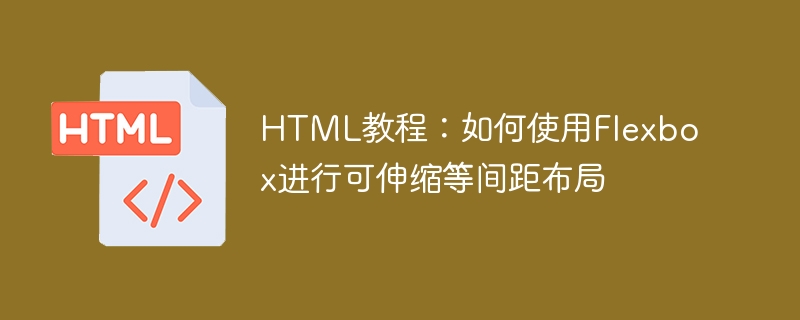

HTML tutorial: How to use Flexbox for scalable equal-spaced layout
Introduction:
In the process of web design and development, page layout is a very important part. For layout, equally spaced layout is a common design requirement. Flexbox (flexible box layout) is a layout mode in CSS3. It has powerful capabilities to achieve different layout requirements, including equal spacing layout. This tutorial will introduce how to use Flexbox to implement a scalable equally spaced layout, and provide specific code examples.
1. Understand the Flexbox layout mode
Flexbox is a CSS module for page layout, which provides a flexible way to arrange, align and distribute elements. Compared with traditional layout methods, Flexbox has the following advantages:
2. Create a Flexbox container
To create a Flexbox layout, you first need to set the display attribute of the element to flex or inline-flex. display:flex sets the element as a block-level element, while display:inline-flex sets the element as an inline element. Here is a simple example:
<div class="container"> <div class="item">Item 1</div> <div class="item">Item 2</div> <div class="item">Item 3</div> </div>
.container {
display: flex;
}
.item {
/* 添加其他样式 */
}After setting the display attribute of the container element to flex, all direct child elements within the container will become Flexbox items.
3. Implement equal spacing layout
To achieve equal spacing layout in Flexbox, we mainly rely on the two attributes of flex-grow and flex-basis. The flex-grow property defines the scaling ratio of each flex item in the flex container, while the flex-basis property defines the initial size of the flex item before allocating excess space. The following is a sample code to implement equal spacing layout:
.container {
display: flex;
justify-content: space-between; /* 每个弹性项平分可用空间 */
}
.item {
flex-grow: 1; /* 弹性项默认伸缩比例为1 */
flex-basis: 0; /* 弹性项初始大小为0 */
/* 添加其他样式 */
}By setting the justify-content property to space-between, the flex items will equally divide the available space, thereby achieving equal spacing layout. In the style of the elastic item, set the flex-grow property to 1, which means that the expansion ratio of each elastic item is equal. Set the flex-basis property to 0, which means that the initial size of each flex item is 0.
4. Apply to actual layout
Now we apply the above equally spaced layout to an actual page layout. Let's say we have a picture wall that contains multiple pictures, and we want the pictures to be equally spaced within the container. The following is a sample code:
.container {
display: flex;
justify-content: space-between;
flex-wrap: wrap; /* 当容器内的弹性项超出一行时换行显示 */
}
.item {
flex-grow: 1;
flex-basis: 0;
width: 30%; /* 每个图片项的宽度为30% */
margin-bottom: 30px; /* 图片项之间的间距为30px */
/* 添加其他样式 */
}In the above code, we create a Flexbox container by setting the display attribute of the container element to flex. Then, we implement equal spacing layout by setting the justify-content attribute to space-between. In the flex item style, we set the width of each image item to 30% and the bottom spacing to 30px.
5. Summary
Using Flexbox for scalable equal-spaced layout is a practical and powerful layout method. By properly setting the properties of the flexible container and flexible items, we can easily implement different types of page layout requirements. I hope this tutorial will be helpful to you in web design and development. Welcome to learn more about Flexbox and explore more of its layout features.
The above is the detailed content of HTML tutorial: How to use Flexbox for scalable equally spaced layout. For more information, please follow other related articles on the PHP Chinese website!